Colonialism
Colonialism is the policy of a country seeking to extend or retain its authority over other people or territories,[1] generally with the aim of economic dominance.[2] In the process of colonisation, colonisers may impose their religion, economics, and other cultural practices on indigenous peoples. The foreign administrators rule the territory in pursuit of their interests, seeking to benefit from the colonised region's people and resources.[3]
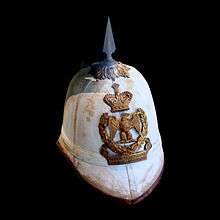
Colonialism is strongly associated with the European colonial period starting with the 15th century when some European states established colonising empires. At first, European colonising countries followed policies of mercantilism, aiming to strengthen the home-country economy, so agreements usually restricted the colonies to trading only with the metropole (mother country). By the mid-19th century, however, the British Empire gave up mercantilism and trade restrictions and adopted the principle of free trade, with few restrictions or tariffs. Christian missionaries were active in practically all of the European-controlled colonies because the metropoles were Christian. Historian Philip Hoffman calculated that by 1800, before the Industrial Revolution, Europeans already controlled at least 35% of the globe, and by 1914, they had gained control of 84% of the globe.[4]
In the aftermath of World War II colonial powers were forced to retreat between 1945–1975, when nearly all colonies gained independence, entering into changed colonial, so-called postcolonial and neocolonialist relations. Postcolonialism and neocolonialism has continued or shifted relations and ideologies of colonialism, justifying its continuation with concepts such as development and new frontiers, as in exploring outer space for colonization.[5]
Definitions

Collins English Dictionary defines colonialism as "the policy and practice of a power in extending control over weaker peoples or areas".[6] Webster's Encyclopedic Dictionary defines colonialism as "the system or policy of a nation seeking to extend or retain its authority over other people or territories".[1] The Merriam-Webster Dictionary offers four definitions, including "something characteristic of a colony" and "control by one power over a dependent area or people".[7] Etymologically, the word "colony" comes from the Latin colōnia—"a place for agriculture".
The Stanford Encyclopedia of Philosophy uses the term "to describe the process of European settlement and political control over the rest of the world, including the Americas, Australia, and parts of Africa and Asia". It discusses the distinction between colonialism, imperialism and conquest and states that "[t]he difficulty of defining colonialism stems from the fact that the term is often used as a synonym for imperialism. Both colonialism and imperialism were forms of conquest that were expected to benefit Europe economically and strategically.", and continues "given the difficulty of consistently distinguishing between the two terms, this entry will use colonialism broadly to refer to the project of European political domination from the sixteenth to the twentieth centuries that ended with the national liberation movements of the 1960s".[8]
In his preface to Jürgen Osterhammel's Colonialism: A Theoretical Overview, Roger Tignor says "For Osterhammel, the essence of colonialism is the existence of colonies, which are by definition governed differently from other territories such as protectorates or informal spheres of influence."[9] In the book, Osterhammel asks, "How can 'colonialism' be defined independently from 'colony?'"[10] He settles on a three-sentence definition:
Colonialism is a relationship between an indigenous (or forcibly imported) majority and a minority of foreign invaders. The fundamental decisions affecting the lives of the colonised people are made and implemented by the colonial rulers in pursuit of interests that are often defined in a distant metropolis. Rejecting cultural compromises with the colonised population, the colonisers are convinced of their own superiority and their ordained mandate to rule.[11]
Types of colonialism

Historians often distinguish between various overlapping forms of colonialism, which are classified into four types: settler colonialism, exploitation colonialism, surrogate colonialism, and internal colonialism.[12]
- Settler colonialism involves large-scale immigration, often motivated by religious, political, or economic reasons. It aims largely to replace any existing population. Here, a large number of people emigrate to the colony for the purpose of staying and cultivating the land.[12] Australia, Canada, and the United States all exemplify settler-colonial societies.[13][14][15]
- Exploitation colonialism involves fewer colonists and focuses on the exploitation of natural resources or population as labour, typically to the benefit of the metropole. This category includes trading posts as well as larger colonies where colonists would constitute much of the political and economic administration. Prior to the end of the trans-Atlantic slave trade and widespread abolition, when indigenous labour was unavailable, slaves were often imported to the Americas, first by the Portuguese, and later by the Spanish, Dutch, French and British.
- Surrogate colonialism involves a settlement project supported by a colonial power, in which most of the settlers do not come from a same ethnic group as the ruling power.
- Internal colonialism is a notion of uneven structural power between areas of a state. The source of exploitation comes from within the state. This is demonstrated in the way control and exploitation may pass from whites from the colonising country to a white immigrant population within a newly independent country.[16]
Socio-cultural evolution
As colonialism often played out in pre-populated areas, sociocultural evolution included the formation of various ethnically hybrid populations. Colonialism gave rise to culturally and ethnically mixed populations such as the mestizos of the Americas, as well as racially divided populations such as those found in French Algeria or in Southern Rhodesia. In fact, everywhere where colonial powers established a consistent and continued presence, hybrid communities existed.
Notable examples in Asia include the Anglo-Burmese, Anglo-Indian, Burgher, Eurasian Singaporean, Filipino mestizo, Kristang and Macanese peoples. In the Dutch East Indies (later Indonesia) the vast majority of "Dutch" settlers were in fact Eurasians known as Indo-Europeans, formally belonging to the European legal class in the colony (see also Indos in pre-colonial history and Indos in colonial history).[17][18]
History
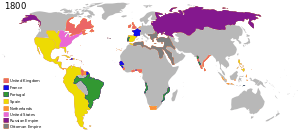 Map of colonial and land-based empires throughout the world in 1800 CE.
Map of colonial and land-based empires throughout the world in 1800 CE.- Map of colonial and land-based empires throughout the world in 1914 CE.
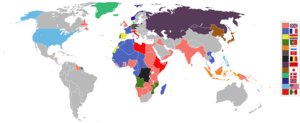 Map of colonial empires (and Soviet Union) throughout the world in 1936 CE.
Map of colonial empires (and Soviet Union) throughout the world in 1936 CE.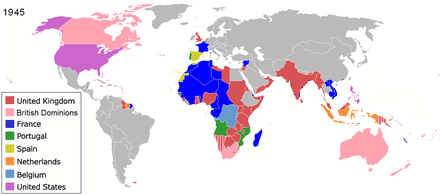 Map of colonial empires at the end of the Second World War, 1945 CE.
Map of colonial empires at the end of the Second World War, 1945 CE.
Ibrahim Muteferrika, Rational basis for the Politics of Nations (1731)[19]
Premodern
Activity that could be called colonialism has a long history starting with the Egyptians, Phoenicians, Greeks and Romans who all built colonies in antiquity. Phoenicia was an enterprising maritime trading culture that spread across the Mediterranean from 1550 BC to 300 BC and later the Greeks and Persians continued on this line of setting up colonies. The Romans would soon follow, setting up colonies throughout the Mediterranean, Northern Africa, and Western Asia. Beginning in the 7th century, Arabs colonized a substantial portion of the Middle East, Northern Africa, and parts of Asia and Europe. In the 9th century a new wave of Mediterranean colonisation had begun between competing states such as the Venetians, Genovese and Amalfians, invading the wealthy previously Byzantine or Eastern Roman islands and lands. Venice began with the conquest of Dalmatia and reached its greatest nominal extent at the conclusion of the Fourth Crusade in 1204, with the declaration of the acquisition of three octaves of the Byzantine Empire.[20]
Modern

Modern colonialism started with the Portuguese Prince Henry the Navigator, initiating the Age of Exploration. Spain (initially the Crown of Castile) and soon later Portugal encountered the Americas through sea travel and built trading posts or conquered large extensions of land. For some people, it is this building of colonies across oceans that differentiates colonialism from other types of expansionism. These new lands were divided between the Spanish Empire and Portuguese Empire.[21]
The 17th century saw the creation of the French colonial empire and the Dutch Empire, as well as the English overseas possessions, which later became the British Empire. It also saw the establishment of a Danish colonial empire and some Swedish overseas colonies.[22]
A first wave of independence was started by the American Revolutionary War (1775–1783), initiating a new phase for the British Empire.[23] The Spanish Empire largely collapsed in the Americas with the Latin American wars of independence. However, many new colonies were established after this time, including the German colonial empire and Belgian colonial empire. In the late 19th century, many European powers were involved in the Scramble for Africa.[24]
The Russian Empire, Ottoman Empire and Austrian Empire existed at the same time as the above empires but did not expand over oceans. Rather, these empires expanded through the more traditional route of the conquest of neighbouring territories. There was, though, some Russian colonisation of the Americas across the Bering Strait. The Empire of Japan modelled itself on European colonial empires. Argentina and the Empire of Brazil fought for hegemony in South America. The United States of America gained overseas territories after the Spanish–American War for which the term "American Empire" was coined.[25]
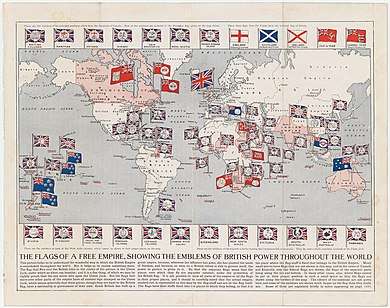
After the First World War, the victorious allies divided up the German colonial empire and much of the Ottoman Empire between themselves as League of Nations mandates. These territories were divided into three classes according to how quickly it was deemed that they would be ready for independence. The empires of Russia and Austria also collapsed.[26]
After World War II decolonisation progressed rapidly. This was caused by a number of reasons. First, the Japanese victories in the Pacific War showed Indians and other subject peoples that the colonial powers were not invincible. Second, all the colonial powers were significantly weakened by World War II.[27]
Dozens of independence movements and global political solidarity projects such as the Non-Aligned Movement were instrumental in the decolonisation efforts of former colonies. These included significant wars of independence fought in Indonesia, Vietnam, Algeria, and Kenya. Eventually, the European powers—pressured by the United States and Soviets—resigned themselves to decolonisation.
In 1962 the United Nations set up a Special Committee on Decolonisation, often called the Committee of 24, to encourage this process.
The status and cost of European colonization at the turn of the 20th century

The world's colonial population at the time of the First World War totalled about 560 million people, of whom 70% were in British possessions, 10% in French possessions, 9% in Dutch possessions, 4% in Japanese possessions, 2% in German possessions, 2% in American possessions, 2% in Portuguese possessions, 1% in Belgian possessions and 1/2 of 1% in Italian possessions. The domestic domains of the colonial powers had a total population of about 370 million people.[28]
Asking whether colonies paid, economic historian Grover Clark argues an emphatic "No!" He reports that in every case the support cost, especially the military system necessary to support and defend the colonies outran the total trade they produced. Apart from the British Empire, they were not favoured destinations for the immigration of surplus populations.[29] The question of whether colonies paid is, however, a complicated one when recognizing the multiplicity of interests involved. In some cases colonial powers were paying a lot in military costs, while the benefits could be pocketed by private investors. In other cases the colonial powers managed to move the burden of administrative costs to the colonies themselves by imposing taxes.[30]
Neocolonialism
The term neocolonialism has been used to refer to a variety of contexts since decolonisation that took place after World War II. Generally it does not refer to a type of direct colonisation, rather, colonialism by other means. Specifically, neocolonialism refers to the theory that former or existing economic relationships, such as the General Agreement on Tariffs and Trade and the Central American Free Trade Agreement, or through companies (such as Royal Dutch Shell in Nigeria and Brunei) created by former colonial powers were or are used to maintain control of their former colonies and dependencies after the colonial independence movements of the post–World War II period.
The term was popular in ex-colonies in the late 20th century.[31]
List of colonies
British colonies and protectorates
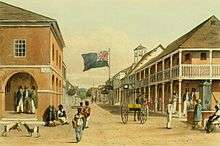

- Aden
- Anglo-Egyptian Sudan
- Ascension Island
- Australia
- Bahamas
- Barbados
- Basutoland
- Bechuanaland
- British Borneo
- Brunei
- Labuan
- North Borneo
- Sarawak
- British East Africa
- British Guiana
- British Honduras
- British Hong Kong
- British Leeward Islands
- Anguilla
- Antigua
- Barbuda
- British Virgin Islands
- Dominica
- Montserrat
- Nevis
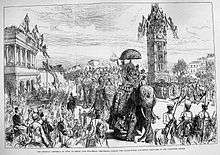 The Delhi Durbar of 1877: the proclamation of Queen Victoria as Empress of India
The Delhi Durbar of 1877: the proclamation of Queen Victoria as Empress of India - Saint Kitts
- British Malaya
.jpg) The First Anglo-Sikh War, 1845–46
The First Anglo-Sikh War, 1845–46 - British Somaliland
- British Western Pacific Territories
- British Solomon Islands
- Fiji
- Gilbert and Ellice Islands
- Phoenix Islands
- Pitcairn Islands
- New Hebrides (condominium with France)
- Tonga
- Union Islands
- British Windward Islands
- Myanmar
- Canada
- Ceylon
- Christmas Island
- Cocos (Keeling) Islands
- Cyprus (including Akrotiri and Dhekelia)
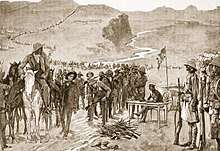 The end result of the Boer Wars was the annexation of the Boer Republics to the British Empire in 1902
The end result of the Boer Wars was the annexation of the Boer Republics to the British Empire in 1902 - Egypt
- Falkland Islands
- Falkland Islands Dependencies
- Graham Land
- South Georgia
- South Orkney Islands
- South Shetland Islands
- South Sandwich Islands
- Victoria Land
- Gambia
- Gibraltar
- Gold Coast
- India (including what is today Pakistan and Bangladesh)
.jpg) A view of shops with anti-British and pro-Independence signs, Malta, c. 1960
A view of shops with anti-British and pro-Independence signs, Malta, c. 1960 - Heard Island and McDonald Islands
- Ireland
- Jamaica
- Kenya
- Maldives
- Malta
- Mandatory Palestine
- Mauritius
- Muscat and Oman
- Norfolk Island
- Nigeria
- Northern Rhodesia
- Nyasaland
_(2).jpg) Gibraltar National Day in British-controlled Gibraltar
Gibraltar National Day in British-controlled Gibraltar - Seychelles
- Sierra Leone
- South Africa
- Southern Rhodesia
- St Helena
- Swaziland
- Trinidad and Tobago
- Tristan da Cunha
- Trucial States
- Uganda
- Tonga

French colonies
- Acadia
- Algeria
- Canada
- Clipperton Island
- Comoros Islands (including Mayotte)
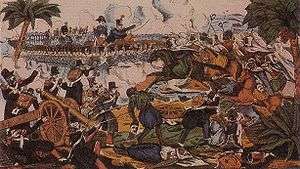 Siege of Constantine (1836) during the French conquest of Algeria.
Siege of Constantine (1836) during the French conquest of Algeria. - Corsica
- French Guiana
- French Equatorial Africa
- French India (Pondichéry, Chandernagor, Karikal, Mahé and Yanaon)
- French Indochina
- Annam
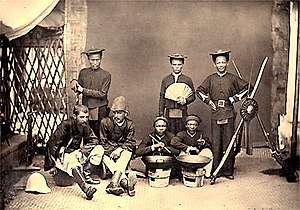 French officers and Tonkinese riflemen, 1884
French officers and Tonkinese riflemen, 1884 - Tonkin
- Cochinchina
- Cambodia
- Laos
- Annam
- French Polynesia
- French Somaliland
- French Southern and Antarctic Lands
- French West Africa
- Ivory Coast
- Dahomey
- Guinea
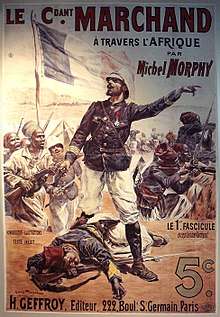 Contemporary illustration of Major Marchand's trek across Africa in 1898
Contemporary illustration of Major Marchand's trek across Africa in 1898 - French Sudan
- Mauritania
- Niger
- Senegal
- Upper Volta
- Guadeloupe
- La Réunion
- Louisiana
- Madagascar
- Martinique
- French Morocco
- Lebanon
- New Caledonia
- Saint-Pierre-et-Miquelon
- Saint-Domingue
- Shanghai French Concession (similar concessions in Kouang-Tchéou-Wan, Tientsin, Hankéou)
- Tunisia
- New Hebrides (condominium with Britain)
- Wallis-et-Futuna
United States colonies and protectorates

- American Concession in Tianjin (1869-1902)
- American Concession in Shanghai (1848-1863)
- American Concession in Beihai (1876-1943)
- American Concession in Harbin (1898-1943)
- American Samoa
- Beijing Legation Quarter (1861-1945)
- Corn Islands (1914–1971)
- Canton and Enderbury Islands
- Cuba (Platt Amendment turned Cuba into a protectorate, protectorate until Cuban Revolution)
- Falkland Islands (1832)
- Guantánamo Bay
- Guam
- Gulangyu Island (1903-1945)
- Haiti
- Isle of Pines (1899-1925)
- Liberia (Independent since 1847, US protectorate until post-WW2)
- Midway
- Nicaragua
- Palmyra Atoll
- Panama (Hay–Bunau-Varilla Treaty turned Panama into a protectorate, protectorate until post-WW2)
- Panama Canal Zone
- Philippines
- Puerto Rico
- Quita Sueño Bank (1869–1981)
- Roncador Bank (1856–1981)
- Shanghai International Settlement (1863-1945)
- Sultanate of Sulu
- Swan Islands, Honduras
- Tangier International Zone (1924-1956)
- Treaty Ports of China, Korea and Japan
- United States Virgin Islands
- Wake Island
- Wilkes Land
Russian colonies and protectorates

German colonies
.jpg)
- Bismarck Archipelago
- Cameroon
- Caroline Islands
- German New Guinea
- German Solomon Islands
- German East Africa
- German South-West Africa
- Gilbert Islands
- Mariana Islands
- Marshall Islands
- Togo
- Tianjin
Italian colonies and protectorates
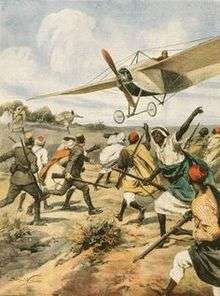
- Italian Aegean Islands
- Italian protectorate of Albania
- Italian governorate of Dalmatia
- Italian governorate of Montenegro
- Italian Concession of Tientsin
- Italian East Africa
- Italian Eritrea
- Italian Ethiopia
- Italian Somaliland
-Italian Trans-Juba (briefly; annexed)
- Italian Libya
Dutch colonies
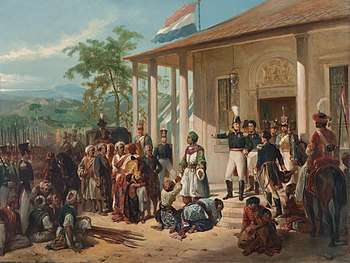
Portuguese colonies
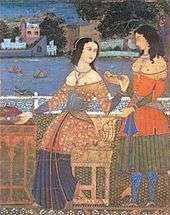
- Portuguese Africa
- Portuguese Asia
- Portuguese Oceania
- Portuguese South America
- Portuguese North America
Spanish colonies
.jpg)
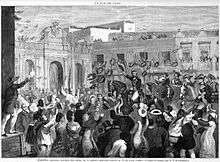
- Canary Islands
- Cape Juby
- Captaincy General of Cuba
- Spanish Florida
- Spanish Louisiana
- Captaincy General of the Philippines
- Caroline Islands
- Mariana Islands
- Palau Islands
- Ifni
- Río de Oro
- Saguia el-Hamra
- Spanish Morocco
- Spanish Netherlands
- Spanish Sahara
- Spanish Sardinia
- Spanish Sicily
- Viceroyalty of Peru
- Viceroyalty of the Río de la Plata
- Viceroyalty of New Granada
- Viceroyalty of New Spain
Austro-Hungarian colonies

Danish colonies

Belgian colonies
Swedish colonies
Polish-Lithuanian colonies and protectorates
- Duchy of Prussia
- Polish Inflanty
- New Courland
- Couronian Africa
- Polish Kaffa
Romanian colonies and occupied territories
Norwegian Overseas Territories
Other non-European colonialist countries
Australian protectorate
New Zealand dependencies

Japanese colonies and protectorates
- Bonin Islands
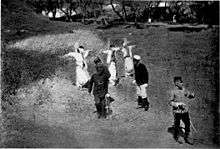 Three Koreans shot for pulling up rails as a protest against seizure of land without payment by the Japanese
Three Koreans shot for pulling up rails as a protest against seizure of land without payment by the Japanese - Karafuto
- Korea
- Kuril Islands
- Kwantung Leased Territory
- Nanyo
- Penghu Islands
- Ryukyu Domain
- Taiwan
- Volcano Islands
Chinese colonies and protectorates

Omani colonies

Mexican colonies
Ecuatorian colonies
Colombian colonies
Argentine colonies and protectorates


- Protectorate of Peru (1820–1822)
- Gobierno del Cerrito (1843–1851)
- Chile (1817–1818)
- Paraguay (1810–1811, 1873)
- Uruguay (1810–1813)
- Bolivia (1810–1822)
- Tierra del Fuego
- Patagonia
- Falkland Islands and Dependencies (1829–1831, 1832–1833, 1982)
- Argentine Antarctica
- Misiones
- Formosa
- Puna de Atacama (1839– )
- invasion Argentina to California (1818)
Chilean colonies
- Arica
- Easter Island
- Patagonia
- Chilean Antarctica
- Puna de Atacama (1879– )
Paraguayan colonies
- Mato Grosso do Sul
- Formosa
Bolivian colonies
- Puna de Atacama (1825–1839 ceded to Argentina) (1825–1879 ceded to Chile)
- Acre
Ethiopian colonies
Moroccan colonies
Indian colonies and protectorates
- Gilgit Baltistan
Thai colonies (Siam)

- Kingdom of Vientiane (1778–1828)
- Kingdom of Luang Prabang (1778–1893)
- Kingdom of Champasak (1778–1893)
- Kingdom of Cambodia (1771–1867)
- Kedah (1821–1826)
- Perlis (1821-1836)
Impact of colonialism and colonisation
The impacts of colonisation are immense and pervasive.[34] Various effects, both immediate and protracted, include the spread of virulent diseases, unequal social relations, detribalization, exploitation, enslavement, medical advances, the creation of new institutions, abolitionism,[35] improved infrastructure,[36] and technological progress.[37] Colonial practices also spur the spread of colonist languages, literature and cultural institutions, while endangering or obliterating those of native peoples. The native cultures of the colonised peoples can also have a powerful influence on the imperial country.[38]
Economy, trade and commerce
Economic expansion, sometimes described as the colonial surplus, has accompanied imperial expansion since ancient times. Greek trade networks spread throughout the Mediterranean region while Roman trade expanded with the primary goal of directing tribute from the colonised areas towards the Roman metropole. According to Strabo, by the time of emperor Augustus, up to 120 Roman ships would set sail every year from Myos Hormos in Roman Egypt to India.[39] With the development of trade routes under the Ottoman Empire,
Gujari Hindus, Syrian Muslims, Jews, Armenians, Christians from south and central Europe operated trading routes that supplied Persian and Arab horses to the armies of all three empires, Mocha coffee to Delhi and Belgrade, Persian silk to India and Istanbul.[40]

Aztec civilisation developed into an extensive empire that, much like the Roman Empire, had the goal of exacting tribute from the conquered colonial areas. For the Aztecs, a significant tribute was the acquisition of sacrificial victims for their religious rituals.[41]
On the other hand, European colonial empires sometimes attempted to channel, restrict and impede trade involving their colonies, funneling activity through the metropole and taxing accordingly.
Despite the general trend of economic expansion, the economic performance of former European colonies varies significantly. In "Institutions as a Fundamental Cause of Long-run Growth", economists Daron Acemoglu, Simon Johnson and James A. Robinson compare the economic influences of the European colonists on different colonies and study what could explain the huge discrepancies in previous European colonies, for example, between West African colonies like Sierra Leone and Hong Kong and Singapore.[42]
According to the paper, economic institutions are the determinant of the colonial success because they determine their financial performance and order for the distribution of resources. At the same time, these institutions are also consequences of political institutions – especially how de facto and de jure political power is allocated. To explain the different colonial cases, we thus need to look first into the political institutions that shaped the economic institutions.[42]

For example, one interesting observation is "the Reversal of Fortune" – the less developed civilisations in 1500, like North America, Australia, and New Zealand, are now much richer than those countries who used to be in the prosperous civilisations in 1500 before the colonists came, like the Mughals in India and the Incas in the Americas. One explanation offered by the paper focuses on the political institutions of the various colonies: it was less likely for European colonists to introduce economic institutions where they could benefit quickly from the extraction of resources in the area. Therefore, given a more developed civilisation and denser population, European colonists would rather keep the existing economic systems than introduce an entirely new system; while in places with little to extract, European colonists would rather establish new economic institutions to protect their interests. Political institutions thus gave rise to different types of economic systems, which determined the colonial economic performance.[42]
European colonisation and development also changed gendered systems of power already in place around the world. In many pre-colonialist areas, women maintained power, prestige, or authority through reproductive or agricultural control. For example, in certain parts of sub-Saharan Africa women maintained farmland in which they had usage rights. While men would make political and communal decisions for a community, the women would control the village's food supply or their individual family's land. This allowed women to achieve power and autonomy, even in patrilineal and patriarchal societies.[43]
Through the rise of European colonialism came a large push for development and industrialisation of most economic systems. However, when working to improve productivity, Europeans focused mostly on male workers. Foreign aid arrived in the form of loans, land, credit, and tools to speed up development, but were only allocated to men. In a more European fashion, women were expected to serve on a more domestic level. The result was a technologic, economic, and class-based gender gap that widened over time.[44]
Within a colony, the presence of extractive colonial institutions in a given area has been found have effects on the modern day economic development, institutions and infrastructure of these areas.[45][46]
Slavery and indentured servitude

European nations entered their imperial projects with the goal of enriching the European metropoles. Exploitation of non-Europeans and of other Europeans to support imperial goals was acceptable to the colonisers. Two outgrowths of this imperial agenda were the extension of slavery and indentured servitude. In the 17th century, nearly two-thirds of English settlers came to North America as indentured servants.[47]
European slave traders brought large numbers of African slaves to the Americas by sail. Spain and Portugal had brought African slaves to work in African colonies such as Cape Verde and São Tomé and Príncipe, and then in Latin America, by the 16th century. The British, French and Dutch joined in the slave trade in subsequent centuries. The European colonial system took approximately 11 million Africans to the Caribbean and to North and South America as slaves.[48]
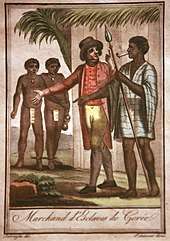
| European empire | Colonial destination | Number of slaves imported between 1450 and 1870[48] |
|---|---|---|
| Portuguese Empire | Brazil | 3,646,800 |
| British Empire | British Caribbean | 1,665,000 |
| French Empire | French Caribbean | 1,600,200 |
| Spanish Empire | Latin America | 1,552,100 |
| Dutch Empire | Dutch Caribbean | 500,000 |
| British Empire | British North America | 399,000 |
Abolitionists in Europe and Americas protested the inhumane treatment of African slaves, which led to the elimination of the slave trade (and later, of most forms of slavery) by the late 19th century. One (disputed) school of thought points to the role of abolitionism in the American Revolution: while the British colonial metropole started to move towards outlawing slavery, slave-owning elites in the Thirteen Colonies saw this as one of the reasons to fight for their post-colonial independence and for the right to develop and continue a largely slave-based economy.[49] British colonising activity in New Zealand from the early 19th century played a part in ending slave-taking and slave-keeping among the indigenous Māori.[50][51] On the other hand, British colonial administration in Southern Africa, when it officially abolished slavery in the 1830s, caused rifts in society which arguably perpetuated slavery in the Boer Republics and fed into the philosophy of apartheid.[52]
The labour shortages that resulted from abolition inspired European colonisers in Queensland, British Guaiana and Fiji (for example) to develop new sources of labour, re-adopting a system of indentured servitude. Indentured servants consented to a contract with the European colonisers. Under their contract, the servant would work for an employer for a term of at least a year, while the employer agreed to pay for the servant's voyage to the colony, possibly pay for the return to the country of origin, and pay the employee a wage as well. The employees became "indentured" to the employer because they owed a debt back to the employer for their travel expense to the colony, which they were expected to pay through their wages. In practice, indentured servants were exploited through terrible working conditions and burdensome debts imposed by the employers, with whom the servants had no means of negotiating the debt once they arrived in the colony.
India and China were the largest source of indentured servants during the colonial era. Indentured servants from India travelled to British colonies in Asia, Africa and the Caribbean, and also to French and Portuguese colonies, while Chinese servants travelled to British and Dutch colonies. Between 1830 and 1930, around 30 million indentured servants migrated from India, and 24 million returned to India. China sent more indentured servants to European colonies, and around the same proportion returned to China.[53]
Following the Scramble for Africa, an early but secondary focus for most colonial regimes was the suppression of slavery and the slave trade. By the end of the colonial period they were mostly successful in this aim, though slavery persists in Africa and in the world at large with much the same practices of de facto servility despite legislative prohibition.[35]
Military innovation

Conquering forces have throughout history applied innovation in order to gain an advantage over the armies of the people they aim to conquer. Greeks developed the phalanx system, which enabled their military units to present themselves to their enemies as a wall, with foot soldiers using shields to cover one another during their advance on the battlefield. Under Philip II of Macedon, they were able to organise thousands of soldiers into a formidable battle force, bringing together carefully trained infantry and cavalry regiments.[54] Alexander the Great exploited this military foundation further during his conquests.
The Spanish Empire held a major advantage over Mesoamerican warriors through the use of weapons made of stronger metal, predominantly iron, which was able to shatter the blades of axes used by the Aztec civilisation and others. The use of gunpowder weapons cemented the European military advantage over the peoples they sought to subjugate in the Americas and elsewhere.
The end of empire

The populations of some colonial territories, such as Canada, enjoyed relative peace and prosperity as part of a European power, at least among the majority; however, minority populations such as First Nations peoples and French-Canadians experienced marginalisation and resented colonial practises. Francophone residents of Quebec, for example, were vocal in opposing conscription into the armed services to fight on behalf of Britain during World War I, resulting in the Conscription crisis of 1917. Other European colonies had much more pronounced conflict between European settlers and the local population. Rebellions broke out in the later decades of the imperial era, such as India's Sepoy Rebellion.
The territorial boundaries imposed by European colonisers, notably in central Africa and South Asia, defied the existing boundaries of native populations that had previously interacted little with one another. European colonisers disregarded native political and cultural animosities, imposing peace upon people under their military control. Native populations were often relocated at the will of the colonial administrators. Once independence from European control was achieved, civil war erupted in some former colonies, as native populations fought to capture territory for their own ethnic, cultural or political group. The Partition of India, a 1947 civil war that came in the aftermath of India's independence from Britain, became a conflict with 500,000 killed. Fighting erupted between Hindu, Sikh and Muslim communities as they fought for territorial dominance. Muslims fought for an independent country to be partitioned where they would not be a religious minority, resulting in the creation of Pakistan.[55]
Post-independence population movement

In a reversal of the migration patterns experienced during the modern colonial era, post-independence era migration followed a route back towards the imperial country. In some cases, this was a movement of settlers of European origin returning to the land of their birth, or to an ancestral birthplace. 900,000 French colonists (known as the Pied-Noirs) resettled in France following Algeria's independence in 1962. A significant number of these migrants were also of Algerian descent. 800,000 people of Portuguese origin migrated to Portugal after the independence of former colonies in Africa between 1974 and 1979; 300,000 settlers of Dutch origin migrated to the Netherlands from the Dutch West Indies after Dutch military control of the colony ended.[56]
After WWII 300,000 Dutchmen from the Dutch East Indies, of which the majority were people of Eurasian descent called Indo Europeans, repatriated to the Netherlands. A significant number later migrated to the US, Canada, Australia and New Zealand.[57][58]
Global travel and migration in general developed at an increasingly brisk pace throughout the era of European colonial expansion. Citizens of the former colonies of European countries may have a privileged status in some respects with regard to immigration rights when settling in the former European imperial nation. For example, rights to dual citizenship may be generous,[59] or larger immigrant quotas may be extended to former colonies.
In some cases, the former European imperial nations continue to foster close political and economic ties with former colonies. The Commonwealth of Nations is an organisation that promotes cooperation between and among Britain and its former colonies, the Commonwealth members. A similar organisation exists for former colonies of France, the Francophonie; the Community of Portuguese Language Countries plays a similar role for former Portuguese colonies, and the Dutch Language Union is the equivalent for former colonies of the Netherlands.
Migration from former colonies has proven to be problematic for European countries, where the majority population may express hostility to ethnic minorities who have immigrated from former colonies. Cultural and religious conflict have often erupted in France in recent decades, between immigrants from the Maghreb countries of north Africa and the majority population of France. Nonetheless, immigration has changed the ethnic composition of France; by the 1980s, 25% of the total population of "inner Paris" and 14% of the metropolitan region were of foreign origin, mainly Algerian.[60]
Introduced diseases
Encounters between explorers and populations in the rest of the world often introduced new diseases, which sometimes caused local epidemics of extraordinary virulence.[61] For example, smallpox, measles, malaria, yellow fever, and others were unknown in pre-Columbian America.[62]
Half the native population of Hispaniola in 1518 was killed by smallpox. Smallpox also ravaged Mexico in the 1520s, killing 150,000 in Tenochtitlan alone, including the emperor, and Peru in the 1530s, aiding the European conquerors. Measles killed a further two million Mexican natives in the 17th century. In 1618–1619, smallpox wiped out 90% of the Massachusetts Bay Native Americans.[63] Smallpox epidemics in 1780–1782 and 1837–1838 brought devastation and drastic depopulation among the Plains Indians.[64] Some believe that the death of up to 95% of the Native American population of the New World was caused by Old World diseases.[65] Over the centuries, the Europeans had developed high degrees of immunity to these diseases, while the indigenous peoples had no time to build such immunity.[66]
Smallpox decimated the native population of Australia, killing around 50% of indigenous Australians in the early years of British colonisation.[67] It also killed many New Zealand Māori.[68] As late as 1848–49, as many as 40,000 out of 150,000 Hawaiians are estimated to have died of measles, whooping cough and influenza. Introduced diseases, notably smallpox, nearly wiped out the native population of Easter Island.[69] In 1875, measles killed over 40,000 Fijians, approximately one-third of the population.[70] The Ainu population decreased drastically in the 19th century, due in large part to infectious diseases brought by Japanese settlers pouring into Hokkaido.[71]
Conversely, researchers have hypothesised that a precursor to syphilis may have been carried from the New World to Europe after Columbus's voyages. The findings suggested Europeans could have carried the nonvenereal tropical bacteria home, where the organisms may have mutated into a more deadly form in the different conditions of Europe.[72] The disease was more frequently fatal than it is today; syphilis was a major killer in Europe during the Renaissance.[73] The first cholera pandemic began in Bengal, then spread across India by 1820. Ten thousand British troops and countless Indians died during this pandemic.[74] Between 1736 and 1834 only some 10% of East India Company's officers survived to take the final voyage home.[75] Waldemar Haffkine, who mainly worked in India, who developed and used vaccines against cholera and bubonic plague in the 1890s, is considered the first microbiologist.
Countering disease
As early as 1803, the Spanish Crown organised a mission (the Balmis expedition) to transport the smallpox vaccine to the Spanish colonies, and establish mass vaccination programs there.[76] By 1832, the federal government of the United States established a smallpox vaccination program for Native Americans.[77] Under the direction of Mountstuart Elphinstone a program was launched to propagate smallpox vaccination in India.[78] From the beginning of the 20th century onwards, the elimination or control of disease in tropical countries became a driving force for all colonial powers.[79] The sleeping sickness epidemic in Africa was arrested due to mobile teams systematically screening millions of people at risk.[80] In the 20th century, the world saw the biggest increase in its population in human history due to lessening of the mortality rate in many countries due to medical advances.[81] The world population has grown from 1.6 billion in 1900 to over seven billion today.
Colonialism and the history of thought
Universalism
The conquest of vast territories brings multitudes of diverse cultures under the central control of the imperial authorities. From the time of Ancient Greece and Ancient Rome, this fact has been addressed by empires adopting the concept of universalism, and applying it to their imperial policies towards their subjects far from the imperial capitol. The capitol, the metropole, was the source of ostensibly enlightened policies imposed throughout the distant colonies.
The empire that grew from Greek conquest, particularly by Alexander the Great, spurred the spread of Greek language, religion, science and philosophy throughout the colonies. While most Greeks considered their own culture superior to all others (the word barbarian is derived from mutterings that sounded to Greek ears like "bar-bar"), Alexander was unique in promoting a campaign to win the hearts and minds of the Persians. He adopted Persian customs of clothing and otherwise encouraged his men to go native by adopting local wives and learning their mannerisms. Of note is that he radically departed from earlier Greek attempts at colonisation, characterised by the murder and enslavement of the local inhabitants and the settling of Greek citizens from the polis.
Roman universalism was characterised by cultural and religious tolerance and a focus on civil efficiency and the rule of law. Roman law was imposed on both Roman citizens and colonial subjects. Although Imperial Rome had no public education, Latin spread through its use in government and trade. Roman law prohibited local leaders to wage war between themselves, which was responsible for the 200 year long Pax Romana, at the time the longest period of peace in history. The Roman Empire was tolerant of diverse cultures and religious practises, even allowing them on a few occasions to threaten Roman authority.
Colonialism and geography
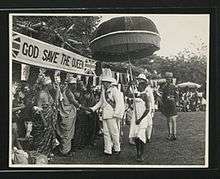
Settlers acted as the link between indigenous populations and the imperial hegemony, thus bridging the geographical, ideological and commercial gap between the colonisers and colonised. While the extent in which geography as an academic study is implicated in colonialism is contentious, geographical tools such as cartography, shipbuilding, navigation, mining and agricultural productivity were instrumental in European colonial expansion. Colonisers' awareness of the Earth's surface and abundance of practical skills provided colonisers with a knowledge that, in turn, created power.[82]
Anne Godlewska and Neil Smith argue that "empire was 'quintessentially a geographical project'".[83] Historical geographical theories such as environmental determinism legitimised colonialism by positing the view that some parts of the world were underdeveloped, which created notions of skewed evolution.[82] Geographers such as Ellen Churchill Semple and Ellsworth Huntington put forward the notion that northern climates bred vigour and intelligence as opposed to those indigenous to tropical climates (See The Tropics) viz a viz a combination of environmental determinism and Social Darwinism in their approach.[84]
Political geographers also maintain that colonial behaviour was reinforced by the physical mapping of the world, therefore creating a visual separation between "them" and "us". Geographers are primarily focused on the spaces of colonialism and imperialism; more specifically, the material and symbolic appropriation of space enabling colonialism.[85]:5

Maps played an extensive role in colonialism, as Bassett would put it "by providing geographical information in a convenient and standardised format, cartographers helped open West Africa to European conquest, commerce, and colonisation".[86] However, because the relationship between colonialism and geography was not scientifically objective, cartography was often manipulated during the colonial era. Social norms and values had an effect on the constructing of maps. During colonialism map-makers used rhetoric in their formation of boundaries and in their art. The rhetoric favoured the view of the conquering Europeans; this is evident in the fact that any map created by a non-European was instantly regarded as inaccurate. Furthermore, European cartographers were required to follow a set of rules which led to ethnocentrism; portraying one's own ethnicity in the centre of the map. As J.B. Harley put it, "The steps in making a map – selection, omission, simplification, classification, the creation of hierarchies, and 'symbolisation' – are all inherently rhetorical."[87]
A common practice by the European cartographers of the time was to map unexplored areas as "blank spaces". This influenced the colonial powers as it sparked competition amongst them to explore and colonise these regions. Imperialists aggressively and passionately looked forward to filling these spaces for the glory of their respective countries.[88] The Dictionary of Human Geography notes that cartography was used to empty 'undiscovered' lands of their Indigenous meaning and bring them into spatial existence via the imposition of "Western place-names and borders, [therefore] priming 'virgin' (putatively empty land, 'wilderness') for colonisation (thus sexualising colonial landscapes as domains of male penetration), reconfiguring alien space as absolute, quantifiable and separable (as property)."[89]
David Livingstone stresses "that geography has meant different things at different times and in different places" and that we should keep an open mind in regards to the relationship between geography and colonialism instead of identifying boundaries.[83] Geography as a discipline was not and is not an objective science, Painter and Jeffrey argue, rather it is based on assumptions about the physical world.[82] Comparison of exogeographical representations of ostensibly tropical environments in science fiction art support this conjecture, finding the notion of the tropics to be an artificial collection of ideas and beliefs that are independent of geography.[90]
Colonialism and imperialism

A colony is a part of an empire and so colonialism is closely related to imperialism. Assumptions are that colonialism and imperialism are interchangeable, however Robert J. C. Young suggests that imperialism is the concept while colonialism is the practice. Colonialism is based on an imperial outlook, thereby creating a consequential relationship. Through an empire, colonialism is established and capitalism is expanded, on the other hand a capitalist economy naturally enforces an empire. In the next section Marxists make a case for this mutually reinforcing relationship.
Marxist view of colonialism
Marxism views colonialism as a form of capitalism, enforcing exploitation and social change. Marx thought that working within the global capitalist system, colonialism is closely associated with uneven development. It is an "instrument of wholesale destruction, dependency and systematic exploitation producing distorted economies, socio-psychological disorientation, massive poverty and neocolonial dependency".[91] Colonies are constructed into modes of production. The search for raw materials and the current search for new investment opportunities is a result of inter-capitalist rivalry for capital accumulation. Lenin regarded colonialism as the root cause of imperialism, as imperialism was distinguished by monopoly capitalism via colonialism and as Lyal S. Sunga explains: "Vladimir Lenin advocated forcefully the principle of self-determination of peoples in his "Theses on the Socialist Revolution and the Right of Nations to Self-Determination" as an integral plank in the programme of socialist internationalism" and he quotes Lenin who contended that "The right of nations to self-determination implies exclusively the right to independence in the political sense, the right to free political separation from the oppressor nation. Specifically, this demand for political democracy implies complete freedom to agitate for secession and for a referendum on secession by the seceding nation."[92] Non Russian marxists within the RSFSR and later the USSR, like Sultan Galiev and Vasyl Shakhrai, meanwhile, between 1918 and 1923 and then after 1929, considered the Soviet Regime a renewed version of the Russian imperialism and colonialism.
In his critique of colonialism in Africa, the Guyanese historian and political activist Walter Rodney states:
- "The decisiveness of the short period of colonialism and its negative consequences for Africa spring mainly from the fact that Africa lost power. Power is the ultimate determinant in human society, being basic to the relations within any group and between groups. It implies the ability to defend one's interests and if necessary to impose one's will by any means available ... When one society finds itself forced to relinquish power entirely to another society that in itself is a form of underdevelopment ... During the centuries of pre-colonial trade, some control over social political and economic life was retained in Africa, in spite of the disadvantageous commerce with Europeans. That little control over internal matters disappeared under colonialism. Colonialism went much further than trade. It meant a tendency towards direct appropriation by Europeans of the social institutions within Africa. Africans ceased to set indigenous cultural goals and standards, and lost full command of training young members of the society. Those were undoubtedly major steps backwards ... Colonialism was not merely a system of exploitation, but one whose essential purpose was to repatriate the profits to the so-called 'mother country'. From an African view-point, that amounted to consistent expatriation of surplus produced by African labour out of African resources. It meant the development of Europe as part of the same dialectical process in which Africa was underdeveloped.
- "Colonial Africa fell within that part of the international capitalist economy from which surplus was drawn to feed the metropolitan sector. As seen earlier, exploitation of land and labour is essential for human social advance, but only on the assumption that the product is made available within the area where the exploitation takes place."[93][94]
According to Lenin, the new imperialism emphasised the transition of capitalism from free trade to a stage of monopoly capitalism to finance capital. He states it is, "connected with the intensification of the struggle for the partition of the world". As free trade thrives on exports of commodities, monopoly capitalism thrived on the export of capital amassed by profits from banks and industry. This, to Lenin, was the highest stage of capitalism. He goes on to state that this form of capitalism was doomed for war between the capitalists and the exploited nations with the former inevitably losing. War is stated to be the consequence of imperialism. As a continuation of this thought G.N. Uzoigwe states, "But it is now clear from more serious investigations of African history in this period that imperialism was essentially economic in its fundamental impulses."[95]
Liberalism, capitalism and colonialism
Classical liberals were generally in abstract opposition to colonialism and imperialism, including Adam Smith, Frédéric Bastiat, Richard Cobden, John Bright, Henry Richard, Herbert Spencer, H.R. Fox Bourne, Edward Morel, Josephine Butler, W.J. Fox and William Ewart Gladstone.[96] Their philosophies found the colonial enterprise, particularly mercantilism, in opposition to the principles of free trade and liberal policies.[97] Adam Smith wrote in The Wealth of Nations that Britain should grant independence to all of its colonies and also argued that it would be economically beneficial for British people in the average, although the merchants having mercantilist privileges would lose out.[96][98]
Scientific thought in colonialism, race and gender
During the colonial era, the global process of colonisation served to spread and synthesize the social and political belief systems of the "mother-countries" which often included a belief in a certain natural racial superiority of the race of the mother-country. Colonialism also acted to reinforce these same racial belief systems within the "mother-countries" themselves. Usually also included within the colonial belief systems was a certain belief in the inherent superiority of male over female, however this particular belief was often pre-existing amongst the pre-colonial societies, prior to their colonisation.[99][100][101]
Popular political practices of the time reinforced colonial rule by legitimising European (and/ or Japanese) male authority, and also legitimising female and non-mother-country race inferiority through studies of Craniology, Comparative Anatomy, and Phrenology.[100][101][102] Biologists, naturalists, anthropologists, and ethnologists of the 19th century were focused on the study of colonised indigenous women, as in the case of Georges Cuvier's study of Sarah Baartman.[101] Such cases embraced a natural superiority and inferiority relationship between the races based on the observations of naturalists' from the mother-countries. European studies along these lines gave rise to the perception that African women's anatomy, and especially genitalia, resembled those of mandrills, baboons, and monkeys, thus differentiating colonised Africans from what were viewed as the features of the evolutionarily superior, and thus rightfully authoritarian, European woman.[101]
In addition to what would now be viewed as pseudo-scientific studies of race, which tended to reinforce a belief in an inherent mother-country racial superiority, a new supposedly "science-based" ideology concerning gender roles also then emerged as an adjunct to the general body of beliefs of inherent superiority of the colonial era.[100] Female inferiority across all cultures was emerging as an idea supposedly supported by craniology that led scientists to argue that the typical brain size of the female human was, on the average, slightly smaller than that of the male, thus inferring that therefore female humans must be less developed and less evolutionarily advanced than males.[100] This finding of relative cranial size difference was later simply attributed to the general typical size difference of the human male body versus that of the typical human female body.[103]
Within the former European colonies, non-Europeans and women sometimes faced invasive studies by the colonial powers in the interest of the then prevailing pro-colonial scientific ideology of the day.[101] Such seemingly flawed studies of race and gender coincided with the era of colonialism and the initial introduction of foreign cultures, appearances, and gender roles into the now gradually widening world-views of the scholars of the mother-countries.
The Other
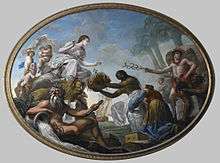
"The Other", or "othering" is the process of creating a separate entity to persons or groups who are labelled as different or non-normal due to the repetition of characteristics.[104] Othering is the creation of those who discriminate, to distinguish, label, categorise those who do not fit in the societal norm. Several scholars in recent decades developed the notion of the "other" as an epistemological concept in social theory.[104] For example, postcolonial scholars, believed that colonising powers explained an "other" who were there to dominate, civilise, and extract resources through colonisation of land.[104]
Political geographers explain how colonial/imperial powers (countries, groups of people etc.) "othered" places they wanted to dominate to legalise their exploitation of the land.[104] During and after the rise of colonialism the Western powers perceived the East as the "other", being different and separate from their societal norm. This viewpoint and separation of culture had divided the Eastern and Western culture creating a dominant/subordinate dynamic, both being the "other" towards themselves.[104]
Post-colonialism

Post-colonialism (or post-colonial theory) can refer to a set of theories in philosophy and literature that grapple with the legacy of colonial rule. In this sense, one can regard post-colonial literature as a branch of postmodern literature concerned with the political and cultural independence of peoples formerly subjugated in colonial empires. Many practitioners take Edward Saïd's book Orientalism (1978) as the theory's founding work (although French theorists such as Aimé Césaire (1913–2008) and Frantz Fanon (1925–1961) made similar claims decades before Saïd).
Saïd analyzed the works of Balzac, Baudelaire and Lautréamont, arguing that they helped to shape a societal fantasy of European racial superiority. Writers of post-colonial fiction interact with the traditional colonial discourse, but modify or subvert it; for instance by retelling a familiar story from the perspective of an oppressed minor character in the story. Gayatri Chakravorty Spivak's Can the Subaltern Speak? (1998) gave its name to Subaltern Studies.
In A Critique of Postcolonial Reason (1999), Spivak argued that major works of European metaphysics (such as those of Kant and Hegel) not only tend to exclude the subaltern from their discussions, but actively prevent non-Europeans from occupying positions as fully human subjects. Hegel's Phenomenology of Spirit (1807), famous for its explicit ethnocentrism, considers Western civilisation as the most accomplished of all, while Kant also had some traces of racialism in his work.
Colonistics
The field of colonistics studies colonialism from such viewpoints as those of economics, sociology and psychology.[105]
Effects of Colonialism on the Colonisers
%2C_Mr._David_Cameron_interacting_with_the_school_children%2C_at_Wembley_Stadium%2C_in_London_on_November_13%2C_2015.jpg)
In his 1955 essay, Discourse on Colonialism (French: Discours sur le colonialisme), French poet Aimé Césaire evaluates the effects of racist, sexist, and capitalist attitudes and motivations on the civilisations that attempted to colonise other civilisations. In explaining his position, he says "I admit that it is a good thing to place different civilisations in contact with each other that it is an excellent thing to blend different worlds; that whatever its own particular genius may be, a civilisation that withdraws into itself atrophies; that for civilisations, exchange is oxygen."[107] However, he contends that colonisation is a harmful and counterproductive means of interacting with and learning from neighbouring civilisations.
To illustrate his point, he explains that colonisation relies on racist and xenophobic frameworks that dehumanise the targets of colonisation and justify their extreme and brutal mistreatment. Every time an immoral act perpetrated by colonisers onto the colonised is justified by racist, sexist, otherwise xenophobic, or capitalist motivations to subjugate a group of people, the colonising civilisation "acquires another dead weight, a universal regression takes place, a gangrene sets in, a centre of infection begins to spread." [107] Césaire argues the result of this process is that "a poison [is] instilled into the veins of Europe and, slowly but surely, the continent proceeds toward savagery." [108] Césaire is indicating that the racist and xenophobic justifications for colonisation—motivated by capitalist desires—ultimately result in the moral and cultural degradation of the colonising nation. Thusly, colonisation is damaging to the civilisations that participate as perpetrators in a way that is internally harmful.
British public opinion about the British Empire
The 2014 YouGov survey found that British people are mostly proud of colonialism and the British Empire:[109]
A new YouGov survey finds that most think the British Empire is more something to be proud of (59%) rather than ashamed of (19%). 23% don't know. Young people are least likely to feel pride over shame when it comes to the Empire, though about half (48%) of 18–24 year old's do. In comparison, about two-thirds (65%) of over 60's feel mostly proud. ... A third of British people (34%) also say they would like it if Britain still had an empire. Under half (45%) say they would not like the Empire to exist today. 20% don't know.[110]
Colonial migrations

Nations and regions outside Europe with significant populations of European ancestry[111]

- Africa (see Europeans in Africa)
- South Africa (European South African): 7.8% of the population[112]
- Namibia (European Namibians): 6.5% of the population, of which most are Afrikaans-speaking, in addition to a German-speaking minority.[113]
- Réunion: estimated to be approx. 25% of the population[114]
- Zimbabwe (Europeans in Zimbabwe)
- Algeria (Pied-noir)[115]
- Botswana: 3% of the population[116]
- Kenya (Europeans in Kenya)
- Mauritius (Franco-Mauritian)
- Morocco (European Moroccans)[117]
- Ivory Coast (French people)[118]
- Senegal[119]
- Canary Islands (Spaniards), known as Canarians.
- Seychelles (Franco-Seychellois)
- Somalia (Italian Somalis)
- Eritrea (Italian Eritreans)
- Saint Helena (UK) including Tristan da Cunha (UK): predominantly European.
- Swaziland: 3% of the population[120]
- Tunisia (European Tunisians)[121]

- Asia
- Siberia (Russians, Germans and Ukrainians)[122][123]
- Kazakhstan (Russians in Kazakhstan, Germans of Kazakhstan): 30% of the population[124][125]
- Uzbekistan (Russians and other Slavs): 6% of the population[125]
- Kyrgyzstan (Russians and other Slavs): 14% of the population[125][126][127]
- Turkmenistan (Russians and other Slavs): 4% of the population[125][128]
- Tajikistan (Russians and other Slavs): 1% of the population[125][129]
- Hong Kong[130]
- Philippines (Spanish Ancestry): 3% of the population
- People's Republic of China (Russians in China)
- Indian subcontinent (Anglo-Indians)
- Latin America (see White Latin American)
 Italian immigrants arriving in São Paulo, Brazil, c. 1890
Italian immigrants arriving in São Paulo, Brazil, c. 1890- Argentina (European Immigration to Argentina): 97% of the population[131]
- Bolivia: 15% of the population[132]
- Brazil (White Brazilian): 47% of the population[133]
- Chile (White Chilean): 60–70% of the population.[134][135][136]
- Colombia (White Colombian): 37% of the population[137]
- Costa Rica: 83% of the population[138]
- Cuba (White Cuban): 65% of the population[139]
- Dominican Republic: 16% of the population[140]
- Ecuador: 7% of the population[141]
- Honduras: 1% of the population[142]
- El Salvador: 12% of the population[143]
- Mexico (White Mexican): 9% or ~17% of the population.[144][145] and 70–80% more as Mestizos.[146][147]
- Nicaragua: 17% of the population[148]
- Panama: 10% of the population[149]
- Puerto Rico: approx. 80% of the population[150]
- Peru (European Peruvian): 15% of the population[151]
- Paraguay: approx. 20% of the population[152]
- Uruguay (White Uruguayan): 88% of the population[153]Mennonites of German descent in Belize
- Venezuela (White Venezuelan): 42% of the population[154]
- Rest of the Americas
- Bahamas: 12% of the population[155]
- Barbados (White Barbadian): 4% of the population[156]
- Bermuda: 34% of the population[157]
- Canada (European Canadians): 80% of the population[158]
- Falkland Islands: mostly of British descent.
- French Guiana: 12% of the population[159]
- Greenland: 12% of the population[160]
- Martinique: 5% of the population[161]
- Saint Barthélemy[162]
- Trinidad and Tobago:[163] 1% of the population
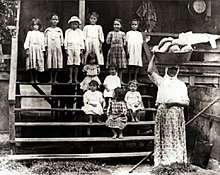 Portuguese immigrant family in Hawaii during the 19th century
Portuguese immigrant family in Hawaii during the 19th century - United States (European American): 72% of the population, including Hispanic and Non-Hispanic Whites.
- Oceania (see Europeans in Oceania)
- Australia (European Australians): 90% of the population
- New Zealand (European New Zealanders): 78% of the population
- New Caledonia (Caldoche): 35% of the population
- French Polynesia: 10% of the population[164]
- Hawaii: 25% of the population[165]
- Christmas Island: approx. 20% of the population.
- Guam: 7% of the population[166]
- Norfolk Island: 9→5% of the population
Numbers of European settlers in the colonies (1500–1914)
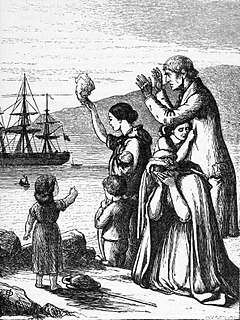
By 1914, Europeans had migrated to the colonies in the millions. Some intended to remain in the colonies as temporary settlers, mainly as military personnel or on business. Others went to the colonies as immigrants. British people were by far the most numerous population to migrate to the colonies: 2.5 million settled in Canada; 1.5 million in Australia; 750,000 in New Zealand; 450,000 in the Union of South Africa; and 200,000 in India. French citizens also migrated in large numbers, mainly to the colonies in the north African Maghreb region: 1.3 million settled in Algeria; 200,000 in Morocco; 100,000 in Tunisia; while only 20,000 migrated to French Indochina. Dutch and German colonies saw relatively scarce European migration, since Dutch and German colonial expansion focused on commercial goals rather than settlement. Portugal sent 150,000 settlers to Angola, 80,000 to Mozambique, and 20,000 to Goa. During the Spanish Empire, approximately 550,000 Spanish settlers migrated to Latin America.[167]
See also
- African independence movements
- Age of Discovery
- American Empire
- Anti-imperialism
- Chartered companies
- Chinese imperialism
- Christianity and colonialism
- Civilising mission
- Colonial Empire
- Colonialism and the Olympic Games
- Coloniality of power
- Colonial wars
- Colonies in antiquity
- Colonisation
- Colony
- Decoloniality
- Decolonisation
- Direct colonial rule
- Empire of Liberty
- European colonial empires
- European colonization of Africa
- European colonization of the Americas
- European colonization of Micronesia
- European colonisation of Southeast Asia
- French law on colonialism
- German eastward expansion
- Global Empire
- Historiography of the British Empire
- Impact of Western European colonialism and colonisation
- Imperialism
- International relations of the Great Powers (1814–1919)
- Muslim conquests
- Orientalism
- Pluricontinental
- Postcolonialism
- Protectorate
- Settler colonialism
- Soviet Empire
- Special Committee on Decolonisation
- Stranger King (Concept)
- Western imperialism in Asia
Notes
- Webster's Encyclopedic Unabridged Dictionary of the English Language, 1989, p. 291.
- Rodney, Walter (2018). How Europe underdeveloped Africa. ISBN 978-1-78873-119-5. OCLC 1048081465.
- Veracini, Lorenzo (2010). Settler Colonialism: A Theoretical Overview. New York: Palgrave Macmillan. pp. 5. ISBN 978-0-230-22097-3.
- Philip T. Hoffman (2015). Why Did Europe Conquer the World?. Princeton University Press. pp. 2–3. ISBN 978-1-4008-6584-0.
- Gabrielle Cornish (22 July 2019). "How imperialism shaped the race to the moon". Washington Post. Retrieved 19 September 2019.
- "Colonialism". Collins English Dictionary. HarperCollins. 2011. Retrieved 8 January 2012.
- "Colonialism". Merriam-Webster. Merriam-Webster. 2010. Retrieved 5 April 2010.
- Margaret Kohn (29 August 2017). "Colonialism". Stanford Encyclopedia of Philosophy. Stanford University. Retrieved 5 May 2018.
- Tignor, Roger (2005). Preface to Colonialism: a theoretical overview. Markus Weiner Publishers. p. x. ISBN 978-1-55876-340-1. Retrieved 5 April 2010.
- Osterhammel, Jürgen (2005). Colonialism: a theoretical overview. trans. Shelley Frisch. Markus Weiner Publishers. p. 15. ISBN 978-1-55876-340-1. Retrieved 5 April 2010.
- Osterhammel, Jürgen (2005). Colonialism: A Theoretical Overview. trans. Shelley Frisch. Markus Weiner Publishers. p. 16. ISBN 978-1-55876-340-1. Retrieved 5 April 2010.
- Healy, Roisin; Dal Lago, Enrico (2014). The Shadow of Colonialism on Europe's Modern Past. New York: Palgrave Macmillan. p. 126. ISBN 978-1-137-45075-3.
- Barker, Adam J. (2009). "The Contemporary Reality of Canadian Imperialism: Settler Colonialism and the Hybrid Colonial State". American Indian Quarterly. 33 (3): 325–351. doi:10.1353/aiq.0.0054. JSTOR 40388468.
- Glenn, Evelyn Nakano (2015). "Settler Colonialism as Structure: A Framework for Comparative Studies of U.S. Race and Gender Formation" (PDF). Sociology of Race and Ethnicity. 1 (1): 52–72. doi:10.1177/2332649214560440.
- Veracini, Lorenzo (2007). "Historylessness: Australia as a settler colonial collective". Postcolonial Studies. 10 (3): 271–285. doi:10.1080/13688790701488155.
- Gabbidon, Shaun (2010). Race, Ethnicity, Crime, and Justice: An International Dilemma. Los Angeles, CA: SAGE. p. 8. ISBN 978-1-4129-4988-0.
- Bosma, U.; Raben, R. (2008). Being "Dutch" in the Indies: A History of Creolisation and Empire, 1500–1920. Singapore: NUS Press. p. 223. ISBN 978-9971-69-373-2.
- Gouda, Frances (2008). "Gender, Race, and Sexuality". Dutch Culture Overseas: Colonial Practice in the Netherlands Indies 1900–1942. Equinox. p. 163. ISBN 978-979-3780-62-7.
- "The 6 killer apps of prosperity". Ted.com. 11 August 2017. Retrieved 11 August 2017.
- Peter N. Stearns, ed., An Encyclopedia of World History (2001) pp 21–238
- Charles R. Boxer, The Portuguese Seaborne Empire, 1415–1825 (1969)
- Thomas Benjamin, ed. Encyclopedia of Western Colonialism Since 1450 (3 vol 2006)
- See David Cody, "The British Empire" The Victorians Web (1988)
- Melvin E. Page, ed., Colonialism: An International Social, Cultural, and Political Encyclopedia (2003).
- Benjamin, ed. Encyclopedia of Western Colonialism Since 1450 (3 vol 2006)
- G.M. Gathorne-Hardy, A Short History of International Affairs, 1920–1939 (4th ed. 1950), online
- Nicholas White, Decolonisation (2014).
- The Russian Empire, Austria-Hungary, Ottoman Empire, Spain and Denmark are not included. U.S. Tariff Commission. Colonial tariff policies (1922), p. 5 online
- Raymond Leslie Buell, "Do Colonies Pay?" The Saturday Review, August 1, 1936 p 6
- Rönnbäck & Broberg (2019) Capital and Colonialism. The Return on British Investments in Africa 1869–1969 (Palgrave Studies in Economic History)
- Uzoigw, Godfrey N. (2019). "Neocolonialism Is Dead: Long Live Neocolonialism". Journal of Global South Studies. 36 (1): 59–87. doi:10.1353/gss.2019.0004.
- Oman Country Profile. Oman Country Profile. British Library Partnership. Qatar Digital Library. 2014.
- Naomi Porat (1992). "An Egyptian Colony in Southern Palestine During the Late Predynastic to Early Dynastic". In Edwin C. M. van den Brink (ed.). The Nile Delta in Transition: 4th.-3rd. Millennium B.C. : Proceedings of the Seminar Held in Cairo, 21.-24. October 1990, at the Netherlands Institute of Archaeology and Arabic Studies. Van den Brink. pp. 433–440. ISBN 978-965-221-015-9. Retrieved 24 February 2013.
- Perry, Alex (2008-02-14). "Come Back, Colonialism, All Is Forgiven". Time. ISSN 0040-781X. Retrieved 2019-09-29.
- Lovejoy, Paul E. (2012). Transformations of Slavery: A History of Slavery in Africa. London: Cambridge University Press.
- Ferguson, Niall (2003). Empire: How Britain Made the Modern World. London: Allen Lane.
- Thong, Tezenlo (2012). "Civilised Colonisers and Barbaric Colonised: Reclaiming Naga Identity by Demythologising Colonial Portraits". History and Anthropology. 23 (3): 375–97. doi:10.1080/02757206.2012.697060.
- Mercy, Olumide, Yetunde (2016-10-06). The Vanishing Black African Woman: Volume Two: A Compendium of the Global Skin-Lightening Practice. Langaa RPCIG. ISBN 978-9956-763-68-9.
- "Strabo's Geography Book II Chapter 5 "
- Pagden, Anthony (2003). Peoples and Empires. New York: Modern Library. p. 45. ISBN 978-0-8129-6761-6.
- Pagden, Anthony (2003). Peoples and Empires. New York: Modern Library. p. 5. ISBN 978-0-8129-6761-6.
- Acemoglu, Daron; Johnson, Simon; Robinson, James A. (2005). "Institutions as a Fundamental Cause of Long-Run Growth". Handbook of Economic Growth. 1A. pp. 385–472. doi:10.1016/S1574-0684(05)01006-3. ISBN 9780444520418.
- Freedman, Estelle (2002). No Turning Back: The History of Feminism and The Future of Women. Random House Publishing Group. pp. 25–26. ISBN 978-0-345-45053-1.
- Freedman, Estelle (2002). No Turning Back: The History of Feminism and The Future of Women. Random House Publishing. pp. 113. ISBN 978-0-345-45053-1.
- Dell, Melissa; Olken, Benjamin A. (2020). "The Development Effects of the Extractive Colonial Economy: The Dutch Cultivation System in Java". The Review of Economic Studies. 87: 164–203. doi:10.1093/restud/rdz017.
- Mattingly, Daniel C. (2017). "Colonial Legacies and State Institutions in China: Evidence From a Natural Experiment" (PDF). Comparative Political Studies. 50 (4): 434–463. doi:10.1177/0010414015600465.
- "White Servitude Archived 2014-10-09 at the Wayback Machine", by Richard Hofstadter, Montgomery College
- King, Russell (2010). People on the Move: An Atlas of Migration. Berkeley, Los Angeles: University of California Press. p. 24. ISBN 978-0-520-26124-2.
-
Hannah-Jones, Nikole (August 14, 2019). "Our democracy's founding ideals were false when they were written. Black Americans have fought to make them true". New York Times Magazine.
The wealth and prominence that allowed Jefferson, at just 33, and the other founding fathers to believe they could successfully break off from one of the mightiest empires in the world came from the dizzying profits generated by chattel slavery. In other words, we may never have revolted against Britain if the founders had not understood that slavery empowered them to do so; nor if they had not believed that independence was required in order to ensure that slavery would continue. It is not incidental that 10 of this nation's first 12 presidents were enslavers, and some might argue that this nation was founded not as a democracy but as a slavocracy.
-
Petrie, Hazel (2015). Outcasts of the Gods? The Struggle over Slavery in Maori New Zealand. Auckland University Press. ISBN 9781775587859. Retrieved 17 June 2020.
Trade with the early explorers, whalers, sealers, and shore-based traders; interaction with missionaries; the availability of muskets; unprecedented warfare; new methods of dispute resolution; and English law all played their part in influencing the increase or decline of Maori captive-taking.
-
Firth, Raymond (2011) [1929]. Primitive Economics of the New Zealand Maori. Routledge Revivals (reprint ed.). Abingdon: Routledge. p. 203. ISBN 9780415694728. Retrieved 17 June 2020.
The economic value of the slave to the community was considerable. [...] Slavery among the Maori is certainly not comparable to the system as it existed among the ancient civilized states of Europe, but relative to the culture of this native people, it played an important part [...].
-
Lowe, Joshua (2014). To what extent was the Great Trek undertaken to preserve Afrikaner Culture?. GRIN. p. 2. ISBN 9783656715245. Retrieved 17 June 2020.
There were also threats to what the Afrikaner perceived as tradition, and slavery was included in this perception.
The abolition of slavery had an effect on why the Great Trek was undertaken and has links to the Afrikaner cultural preservation theory. Slavery was an integral part of Afrikaner society, and there was a sense of discontent when it was called to an end. - King, Russell (2010). People on the Move: An Atlas of Migration. Berkeley, Los Angeles: University of California Press. pp. 26–27. ISBN 978-0-520-26124-2.
- Pagden, Anthony (2003). Peoples and Empires. New York: Modern Library. p. 6. ISBN 978-0-8129-6761-6.
- White, Matthew (2012). The Great Big Book of Horrible Things. W.W. Norton & Co. pp. 427–28. ISBN 978-0-393-08192-3.
- King, Russell (2010). People on the Move: An Atlas of Migration. Berkeley, Los Angeles: University of California Press. p. 35. ISBN 978-0-520-26124-2.
- Willems, Wim "De uittocht uit Indie (1945–1995), De geschiedenis van Indische Nederlanders" (Publisher: Bert Bakker, Amsterdam, 2001). ISBN 90-351-2361-1
- Crul, Lindo and Lin Pang. Culture, Structure and Beyond, Changing identities and social positions of immigrants and their children (Het Spinhuis Publishers, 1999). ISBN 90-5589-173-8
- "British Nationality Act 1981". The National Archives, United Kingdom. Retrieved February 24, 2012.
- Seljuq, Affan (1997). "Cultural Conflicts: North African Immigrants in France". International Journal of Peace Studies. 2 (2): 67–75. JSTOR 45038321.
- Kenneth F. Kiple, ed. The Cambridge Historical Dictionary of Disease (2003).
- Alfred W. Crosby, Jr., The Columbian Exchange: Biological and Cultural Consequences of 1492 (1974)
- Smallpox – The Fight to Eradicate a Global Scourge Archived 2008-09-07 at the Wayback Machine, David A. Koplow.
- Houston, C.S.; Houston, S. (2000). "The first smallpox epidemic on the Canadian Plains: In the fur-traders' words". The Canadian Journal of Infectious Diseases. 11 (2): 112–15. doi:10.1155/2000/782978. PMC 2094753. PMID 18159275.
- "Guns Germs & Steel: Variables. Smallpox | PBS". www.pbs.org. Retrieved 2019-09-29.
- Stacy Goodling, "Effects of European Diseases on the Inhabitants of the New World" Archived 2008-05-10 at the Wayback Machine
- "Smallpox Through History". Archived from the original on 2009-10-29.
- New Zealand Historical Perspective Archived June 12, 2010, at the Wayback Machine
- How did Easter Island's ancient statues lead to the destruction of an entire ecosystem?, The Independent.
- Fiji School of Medicine Archived October 20, 2014, at the Wayback Machine
- Meeting the First Inhabitants Archived June 22, 2011, at the Wayback Machine, TIMEasia.com, 21 August 2000.
- Genetic Study Bolsters Columbus Link to Syphilis, New York Times, January 15, 2008.
- "Columbus May Have Brought Syphilis to Europe". LiveScience.
- Cholera's seven pandemics. CBC News. December 2, 2008.
- "Sahib: The British Soldier in India, 1750–1914 by Richard Holmes [Asi…". archive.fo. 2012-05-30. Archived from the original on 2012-05-30. Retrieved 2019-09-29.
- Dr. Francisco de Balmis and his Mission of Mercy, Society of Philippine Health History. Archived 2004-12-23 at the Wayback Machine
- Lewis Cass and the Politics of Disease: The Indian Vaccination Act of 1832.
- Smallpox History – Other histories of smallpox in South Asia. Archived 2012-04-16 at the Wayback Machine
- Conquest and Disease or Colonialism and Health? Archived 2008-12-07 at the Wayback Machine, Gresham College | Lectures and Events.
- WHO Media centre (2001). "Fact sheet N°259: African trypanosomiasis or sleeping sickness". Cite journal requires
|journal=(help) - Iliffe, John (1989). "The Origins of African Population Growth". The Journal of African History. 30 (1): 165–69. doi:10.1017/s0021853700030942. JSTOR 182701.
- "Painter, J. & Jeffrey, A., 2009. Political Geography, 2nd ed., Sage. "Imperialism" p. 23 (GIC).
- Nayak, Anoop; Jeffrey, Alex (2011). Geographical thought : an introduction to ideas in human geography. Harlow, England: Pearson Prentice Hall. pp. 4–5. ISBN 978-0-13-222824-4.
- Arnold, David (March 2000). ""Illusory Riches": Representations of the Tropical World, 1840–1950". Singapore Journal of Tropical Geography. 21 (1): 6–18. doi:10.1111/1467-9493.00060.
- Gallaher, Carolyn; Dahlman, Carl T.; Gilmartin, Mary; Mountz, Alison; Shirlow, Peter (2009). Key Concepts in Political Geography. London: Sage. p. 392. ISBN 978-1-4129-4672-8. Retrieved July 31, 2014.
- Bassett, Thomas J. (1994). "Cartography and Empire Building in Nineteenth-Century West Africa". Geographical Review. 84 (3): 316–335. doi:10.2307/215456. JSTOR 215456. S2CID 161167051.
- Harley, J. B. (1989). "Deconstructing the Map" (PDF). Cartographica. 26 (2): 1–20. doi:10.3138/E635-7827-1757-9T53.
- Bassett, Thomas J. (1994). "Cartography and Empire Building in Nineteenth-Century West Africa". Geographical Review. 84 (3): 322, 324–25. doi:10.2307/215456. JSTOR 215456. S2CID 161167051.
- Gregory, Derek; Johnston, Ron; Pratt, Geraldine; Watts, Michael; Whatmore, Sarah, eds. (2009). The dictionary of human geography (5th ed.). Chichester (UK): Wiley-Blackwell. pp. 96–97. ISBN 978-1-4051-3288-6.
- Menadue, Christopher Benjamin (2018-09-04). "Cities in Flight: A Descriptive Examination of the Tropical City Imagined in Twentieth Century Science Fiction Cover Art". ETropic: Electronic Journal of Studies in the Tropics. 17 (2). doi:10.25120/etropic.17.2.2018.3658. ISSN 1448-2940.
- Watts, Michael (2005). "colonialism, history of". In Forsyth, Tim (ed.). Encyclopedia of International Development. Routledge. ISBN 9781136952913.
- Sunga, Lyal S. (1997). The Emerging System of International Criminal Law: Developments in Codification and Implementation. Martinus Nijhoff Publishers. pp. 90ff. ISBN 9789041104724. Sunga traces the origin of the international movement against colonialism, and relates it to the rise of the right to self-determination in international law.
- Walter Rodney (1972). How Europe Underdeveloped Africa. East African Publishers. pp. 149, 224. ISBN 978-9966-25-113-8.
- Henry Schwarz; Sangeeta Ray (2004). A Companion To Postcolonial Studies. John Wiley & Sons. p. 271. ISBN 978-0-470-99833-5.
- Boahen, A. Adu. Africa under Colonial Domination 1880–1935. London: Heinemann, 1985. 11. Print.
- Liberal Anti-Imperialism Archived 2011-09-22 at the Wayback Machine, professor Daniel Klein, 1.7.2004
- Hidalgo, Dennis (2007). "Anticolonialism". In Benjamin, Thomas (ed.). Encyclopedia of Western Colonialism since 1450 (Gale Virtual Reference Library ed.). Detroit: Macmillan Reference USA. pp. 57–65. Retrieved May 22, 2015.
- Smith, Adam (1811). The nature and causes of the wealth of nations ("Of Colonies"). London: T. Cadell. pp. 343–84.
- Stoler, Ann L. (Nov 1989). "Making Empire Respectable: The Politics of Race and Sexual Morality in 20th-Century Colonical Cultures" (PDF). American Ethnologist. 16 (4): 634–60. doi:10.1525/ae.1989.16.4.02a00030. hdl:2027.42/136501.
- Fee, E. (1979). "Nineteenth-century craniology: The study of the female skull". Bulletin of the History of Medicine. 53 (3): 415–33. PMID 394780.
- Fausto-Sterling, Anne (2001). "Gender, Race, and Nation: The Comparative Anatomy of "Hottentot" women in Europe, 1815–1817". In Muriel Lederman and Ingrid Bartsch (ed.). The Gender and Science Reader. Routledge.
- Stepan, Nancy (1993). Sandra Harding (ed.). The "Racial" Economy of Science (3 ed.). Indiana University press. pp. 359–76. ISBN 978-0-253-20810-1.
- Male and female brains: the REAL differences 10 February 2016, by Dean Burnett, The Guardian
- Mountz, Alison. The Other, Key Concepts in Human Geography. p. 2.
- Maunier, René (1949). The Sociology of the Colonies [Part 1]: An Introduction to the Study of Race Contact. International Library of Sociology. Translated by Lorimer, E.-O. Routledge (published 2013). p. 137. ISBN 978-1-136-24522-0. Retrieved 7 December 2018.
There are thus three elements in Colonistics or colonial study: Colonial Economics, Colonial Sociology and Colonial Psychology.
- Randall Hansen (2000). Citizenship and Immigration in Postwar Britain. Oxford University Press. ISBN 9780191583018.
- Césaire, Aimé (1955). Discourse on colonialism. New York and London: Monthly Review Press. p. 2. OCLC 849914517.
- Césaire, Aimé (1955). Discourse on colonialism. New York and London: Monthly Review Press. p. 3. OCLC 849914517.
- "Colonial nostalgia is back in fashion, blinding us to the horrors of empire". The Guardian. 24 August 2016.
- Dahlgreen, Will (26 July 2014). "The British Empire is 'something to be proud of'". YouGov.
- Ethnic groups by country. Statistics (where available) from CIA Factbook.
- "South Africa". The World Factbook. Central Intelligence Agency. Retrieved 21 June 2019.
- "Namibia". The World Factbook. Central Intelligence Agency. Retrieved 21 June 2019.
- Tarnus, Evelyne; Bourdon, Emmanuel (2006). "Anthropometric evaluations of body composition of undergraduate students at the University of La Réunion". Advances in Physiology Education. 30 (4): 248–53. doi:10.1152/advan.00069.2005. PMID 17108254. S2CID 19474655.
- Laurenson, John (July 29, 2006). "Former settlers return to Algeria". BBC News.
- Botswana: People: Ethnic Groups. World Factbook of CIA
- De Azevedo, Raimondo Cagiano (1994) Migration and development co-operation.. Council of Europe. p. 25. ISBN 92-871-2611-9.
- "Ivory Coast – The Economy". Library of Congress Country Studies.
- Senegal, About 50,000 Europeans (mostly French) and Lebanese reside in Senegal, mainly in the cities.
- Swaziland: People: Ethnic Groups. World Factbook of CIA
- Tunisia, Worldmark Encyclopedia of the Nations. Thomson Gale. 2007. Encyclopedia.com.
- Fiona Hill, Russia — Coming In From the Cold? Archived 2011-07-15 at the Wayback Machine, The Globalist, 23 February 2004
- "Siberian Germans".
- "Migrant resettlement in the Russian federation: reconstructing 'homes' and 'homelands'". Moya Flynn. (1994). p. 15. ISBN 1-84331-117-8}
- Robert Greenall, "Russians left behind in Central Asia", BBC News, 23 November 2005.
- Kyrgyzstan: People: Ethnic Groups. World Factbook of CIA
- "The Kyrgyz – Children of Manas.". Petr Kokaisl, Pavla Kokaislova (2009). p. 125. ISBN 80-254-6365-6.
- Turkmenistan: People: Ethnic Groups. World Factbook of CIA
- Tajikistan – Ethnic Groups. Source: U.S. Library of Congress.
- HK Census. " HK Census". Statistical Table. Retrieved on 2007-03-08.
- Argentina: People: Ethnic Groups. World Factbook of CIA
- Bolivia: People: Ethnic Groups. World Factbook of CIA
- Brazil: People: Ethnic Groups. World Factbook of CIA
- Fernández, Francisco Lizcano (2007). Composición Étnica de las Tres Áreas Culturales del Continente Americano al Comienzo del Siglo XXI. UAEM. ISBN 978-970-757-052-8.
- Informe Latinobarómetro 2011, Latinobarómetro (p. 58).
- Cruz-Coke, R.; Moreno, R. S. (1994). "Genetic epidemiology of single gene defects in Chile". Journal of Medical Genetics. 31 (9): 702–706. doi:10.1136/jmg.31.9.702. PMC 1050080. PMID 7815439.
- Colombia: People: Ethnic Groups. World Factbook of CIA
- "Costa Rica; People; Ethnic groups". CIA World Factbook. Retrieved 2007-11-21.
white (including mestizo) 94%
= 3.9 million whites and mestizos - "Tabla II.3 Población por color de la piel y grupos de edades, según zona de residencia y sexo". Censo de Población y Viviendas (in Spanish). Oficina Nacional de Estadísticas. 2002. Retrieved 2008-10-13.
- Dominican Republic: People: Ethnic groups. World Factbook of CIA
- "Ecuador: People; Ethnic groups". CIA World Factbook. Retrieved 2007-11-26.
- "Central America and Caribbean :: HONDURAS". CIA The World Factbook.
- El Salvador: People: Ethnic Groups. World Factbook of CIA
- "Mexico: People; Ethnic groups". CIA World Factbook. Retrieved 2010-01-24.
- "Mexico: Ethnic Groups". Encyclopædia Britannica.
- Mexico: People: Ethnic Groups. World Factbook of CIA
- Mexico – Britannica Online Encyclopedia
- "Nicaragua: People; Ethnic groups". CIA World Factbook. Retrieved 2007-11-15.
- "Panama; People; Ethnic groups". CIA World Factbook. Retrieved 2007-11-21.
- Puerto Rico: People: Ethnic Groups World Factbook of CIA
- Peru: People: Ethnic Groups. World Factbook of CIA
- 8 LIZCANO Archived June 26, 2013, at the Wayback Machine
- Uruguay: People: Ethnic Groups. World Factbook of CIA
- Resultado Basico del XIV Censo Nacional de Población y Vivienda 2011 (p. 14).
- Bahamas: People: Ethnic Groups. World Factbook of CIA
- Barbados: People: Ethnic Groups. World Factbook of CIA
- Bermuda: People: Ethnic Groups. World Factbook of CIA
- Canadian Census 2006
- French Guiana: People: Ethnic Groups. World Factbook of CIA
- Greenland
- Martinique: People: Ethnic Groups. World Factbook of CIA
- Fact Sheet on St. Barthélemy
- Trinidad French Creole
- French Polynesia: People: Ethnic Groups. World Factbook of CIA
- American FactFinder – Results
- Brazil: People: Ethnic Groups. World Factbook of CIA
- King, Russell (2010). People on the Move: An Atlas of Migration. Berkeley, Los Angeles: University of California Press. pp. 34–35. ISBN 978-0-520-26151-8.
Further reading
- Albertini, Rudolf von. European Colonial Rule, 1880–1940: The Impact of the West on India, Southeast Asia, and Africa (1982) 581 pp
- Benjamin, Thomas, ed. Encyclopedia of Western Colonialism Since 1450 (2006)
- Cooper, Frederick. Colonialism in Question: Theory, Knowledge, History (2005)
- Cotterell, Arthur. Western Power in Asia: Its Slow Rise and Swift Fall, 1415 – 1999 (2009) popular history; excerpt
- Getz, Trevor R. and Heather Streets-Salter, eds.: Modern Imperialism and Colonialism: A Global Perspective (2010)
- LeCour Grandmaison, Olivier: Coloniser, Exterminer – Sur la guerre et l'Etat colonial, Fayard, 2005, ISBN 2-213-62316-3
- Lindqvist, Sven: Exterminate All The Brutes, 1992, New Press; Reprint edition (June 1997), ISBN 978-1-56584-359-2
- Ness, Immanuel and Zak Cope, eds. The Palgrave Encyclopedia of Imperialism and Anti-Imperialism (2 vol 2015), 1456 pp
- Nuzzo, Luigi: Colonial Law, European History Online, Mainz: Institute of European History, 2010, retrieved: December 17, 2012.
- Osterhammel, Jürgen: Colonialism: A Theoretical Overview, Princeton, NJ: M. Wiener, 1997.
- Page, Melvin E. et al. eds. Colonialism: An International Social, Cultural, and Political Encyclopedia (3 vol 2003)
- Petringa, Maria, Brazza, A Life for Africa (2006), ISBN 978-1-4259-1198-0.
- Rönnbäck, K. & Broberg, O. (2019) Capital and Colonialism. The Return on British Investments in Africa 1869–1969 (Palgrave Studies in Economic History)
- Schill, Pierre : Réveiller l'archive d'une guerre coloniale. Photographies et écrits de Gaston Chérau, correspondant de guerre lors du conflit italo-turc pour la Libye (1911–1912), Créaphis, 480 p., 2018 (ISBN 978-2-35428-141-0). Awaken the archive of a colonial war. Photographs and writings of a French war correspondent during the Italo-Turkish war in Libya (1911–1912). With contributions from art historian Caroline Recher, critic Smaranda Olcèse, writer Mathieu Larnaudie and historian Quentin Deluermoz.
- Stuchtey, Benedikt: Colonialism and Imperialism, 1450–1950, European History Online, Mainz: Institute of European History, 2011, retrieved: July 13, 2011.
- Townsend, Mary Evelyn. European colonial expansion since 1871 (1941).
- U.S. Tariff Commission. Colonial tariff policies (1922), worldwide; 922pp survey online
- Velychenko, Stephen (2002). "The Issue of Russian Colonialism in Ukrainian Thought. Dependency Identity and Development". Ab Imperio. 2002 (1): 323–367. doi:10.1353/imp.2002.0070.
- Wendt, Reinhard: European Overseas Rule, European History Online, Mainz: Institute of European History, 2011, retrieved: June 13, 2012.
Primary sources
- Conrad, Joseph, Heart of Darkness, 1899
- Fanon, Frantz, The Wretched of the Earth, Preface by Jean-Paul Sartre. Translated by Constance Farrington. London: Penguin Book, 2001
- Kipling, Rudyard, The White Man's Burden, 1899
- Las Casas, Bartolomé de, A Short Account of the Destruction of the Indies (1542, published in 1552).
External links

- Kohn, Margaret. "Colonialism". In Zalta, Edward N. (ed.). Stanford Encyclopedia of Philosophy.
